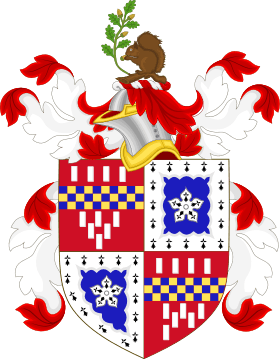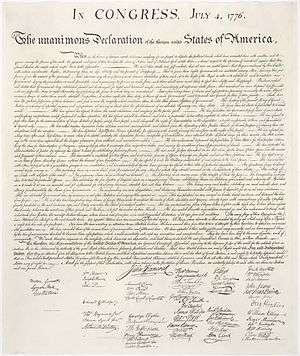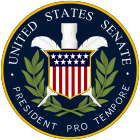Richard Henry Lee
Richard Henry Lee (January 20, 1732 – June 19, 1794) was an American statesman and Founding Father from Virginia best known for the June 1776 Lee Resolution, the motion in the Second Continental Congress calling for the colonies' independence from Great Britain leading to the United States Declaration of Independence, which he signed. He also served a one-year term as the President of the Continental Congress, was a signatory to the Articles of Confederation, and was a United States Senator from Virginia from 1789 to 1792, serving during part of that time as the second President pro tempore of the upper house.
Richard Henry Lee | |
|---|---|
Portrait of Lee by Charles Willson Peale | |
| President pro tempore of the United States Senate | |
| In office April 18, 1792 – October 8, 1792 | |
| Preceded by | John Langdon |
| Succeeded by | John Langdon |
| United States Senator from Virginia | |
| In office March 4, 1789 – October 8, 1792 | |
| Preceded by | Inaugural Holder |
| Succeeded by | John Taylor |
| 4th President of the Congress of the Confederation | |
| In office November 30, 1784 – November 4, 1785 | |
| Preceded by | Thomas Mifflin |
| Succeeded by | John Hancock |
| Delegate to the Congress of the Confederation from Virginia | |
| In office November 1, 1784 – October 30, 1787 | |
| Member of the Virginia House of Burgesses from Westmoreland County | |
| In office September 14, 1758 – May 6, 1776 | |
| Preceded by | Augustine Washington |
| Succeeded by | Position abolished |
| Personal details | |
| Born | January 20, 1732 Westmoreland County, Colony of Virginia, British America |
| Died | June 19, 1794 (aged 62) Westmoreland County, Virginia, U.S. |
| Resting place | Burnt House Fields, Lee Family Estate, Coles Point, Westmoreland County, Virginia |
| Political party | Anti-Administration |
| Spouse(s) | Anne Aylett (died 1768) Anne (Gaskins) Pinckard |
| Children | 13 |
| Parents | Thomas Lee Hannah Harrison Ludwell |
| Profession | Law |
| Signature | |
He was a member of the Lee family, a historically influential family in Virginia politics.
Early life and education
He was born in Westmoreland County, Virginia to Col. Thomas Lee and Hannah Harrison Ludwell Lee on January 20, 1732. He was raised and came from a line of military officers, diplomats, and legislators. His father, Thomas Lee, was the governor of Virginia before his death in 1750. Lee spent most of his early life in Stratford, Virginia with his family at Stratford Hall. Here he was tutored and taught in a variety of skills, and witnessed the very beginning of political career as his father sent him around to neighboring planters with the intention for Lee to become associated with neighboring men of like prominence. In 1748, at 16, Lee left Virginia for Yorkshire, England, to complete his formal education at Queen Elizabeth Grammar School, Wakefield. Both of his parents died in 1750 and, in 1753, after touring Europe, he returned to Virginia to help his brothers settle the estate his parents had left behind.[1]
Career
In 1757, Lee was appointed justice of the peace in Westmoreland County. In 1758 he was elected to the Virginia House of Burgesses, where he met Patrick Henry. An early advocate of independence, Lee became one of the first to create Committees of Correspondence among the many independence-minded Americans in the various colonies. In 1766, almost ten years before the American Revolutionary War, Lee is credited with having authored the Westmoreland Resolution[2] which was publicly signed by prominent landowners who met at Leedstown, Westmoreland County, Virginia on February 27, 1766. This resolution was signed by four brothers of George Washington as well as Gilbert Campbell.
American Revolution
In August 1774, Lee was chosen as a delegate to the First Continental Congress in Philadelphia. In Lee's Resolution on June 7, 1776 during the Second Continental Congress, Lee put forth the motion to the Continental Congress to declare Independence from Great Britain, which read (in part):
Resolved: That these United Colonies are, and of right ought to be, free and independent States, that they are absolved from all allegiance to the British Crown, and that all political connection between them and the State of Great Britain is, and ought to be, totally dissolved.
Lee had returned to Virginia by the time Congress voted on and adopted the Declaration of Independence, but he signed the document when he returned to Congress.

President of Congress
Lee was elected sixth president of Congress under the Articles of Confederation on November 30, 1784, in the French Arms Tavern, Trenton, New Jersey. Congress convened on January 11, 1785, in the old New York City Hall, with Lee presiding until November 23, 1785. Although he was not paid a salary, his household expenses were covered in the amount of $12,203.13.[3]
Lee abhorred the notion of imposing federal taxes and believed that continuing to borrow foreign money was imprudent. Throughout his term, he maintained that the states should relinquish their claims in the Northwest Territory, enabling the federal government to fund its obligations though land sales. He wrote to friend and colleague Samuel Adams:
I hope we shall shortly finish our plan for disposing of the western Lands to discharge the oppressive public debt created by the war & I think that if this source of revenue be rightly managed, that these republics may soon be discharged from that state of oppression and distress that an indebted people must invariably feel.[4]
Debate began on the expansion of the Ordinance of 1784 and Thomas Jefferson's survey method; namely, "hundreds of ten geographical miles square, each mile containing 6086 and 4-10ths of a foot" and "sub-divided into lots of one mile square each, or 850 and 4-10ths of an acre" on April 14.[5] On May 3, 1785, William Grayson of Virginia made a motion, seconded by James Monroe, to change "seven miles square" to "six miles square."
The Land Ordinance of 1785 passed on May 20, 1785, yet the federal government lacked the resources to manage the newly surveyed lands. Not only did Native Americans refuse to relinquish their hold on the platted territory, but much of the remaining land was occupied by squatters. With Congress unable to muster magistrates or troops to enforce the dollar-per-acre title fee, Lee's plan ultimately failed, although the survey system developed under the Land Ordinance of 1785 has endured.
Political offices
- Justice of the Peace for Westmoreland County, Virginia (1757)
- Virginia House of Burgesses (1758–1775)
- Member of the Continental Congress (1774–1779, 1784–1785, 1787)
- A Signer of the Declaration of Independence (1776)
- Virginia House of Delegates (1777, 1780, 1785)
- President of the Confederation Congress (November 30, 1784 – November 4, 1785)
- United States Senator from Virginia (March 4, 1789 – October 8, 1792)
- President pro tempore during the Second Congress (April 18 – October 8, 1792)
Personal life and family
Lee was the son of Col. Thomas Lee, Hon. (1690–1750) of "Stratford Hall", Westmoreland Co., Virginia. Thomas married Hannah Harrison Ludwell (1701–1750).
Lee married first on December 5, 1757, Anne Aylett (1738–1768), daughter of William Aylett and Elizabeth Eskridge (1719). Anne died December 12, 1768, at Chantille, Westmoreland Co., Virginia. The couple had six children, four of whom survived infancy.
Lee remarried in June or July 1769 to Anne (Gaskins) Pinckard. The couple had seven children, five of whom survived infancy.
Lee honored his brother, Francis Lightfoot Lee (another signer of the Articles of Confederation and the Declaration of Independence), by naming his fourth son after him.
Richard Henry Lee died on June 19, 1794, at the age of 62.
Legacy
Lee is recognized as a Founding Father of the United States. Richard Henry Lee Elementary School in Rossmoor, California and Richard Henry Lee School in Chicago, Illinois are named in his honor. Richard Henry Lee Elementary in Glen Burnie, Maryland is also named after him.
The World War II Liberty Ship SS Richard Henry Lee was named in his honor.
The Chantilly Archaeological Site was listed on the National Register of Historic Places in 1971.[6]
In popular culture
Lee is portrayed as a character in the 1969 musical 1776. He was portrayed by Ron Holgate in both the Broadway cast and in the 1972 film. In one scene, Lee performs a song called "The Lees of Old Virginia," in which he explains how he knows he will be able to convince the Virginia House of Burgesses to allow him to propose independence and celebrates his own status as a Lee, one of the First Families of Virginia. The character is presented as vain, but not very bright, serving the play as a comic device rather than a historically based portrayal of Lee.
Lee is portrayed by Paul Fitzgerald in the 2008 HBO miniseries John Adams. Although Lee had returned to Virginia, and thus was not present to vote on the Resolution for Independence, the miniseries portrays him as being present and casting the vote for the Virginia delegation. The miniseries does show the fact that Lee always had his hand wrapped in black silk to hide the deformation caused by a hunting accident.
References
- McGaughy, J. K. Richard Henry Lee (1732–1794). (March 18, 2014). In Encyclopedia Virginia. Retrieved from http://www.EncyclopediaVirginia.org/ Lee Richard Henry 1732–1794
- Washington, Lawrence; McKim, Randolph Harrison; Beale, George William (January 1, 1912). Westmoreland County, Virginia: Parts I and II : a Short Chapter and Bright Day in Its History. Whittet & Shepperson, printers. p. 42. Retrieved September 22, 2016 – via Internet Archive.
Westmoreland Resolution.
- Estimate of the Annual Expenditure of the Civil Departments of the United States, on the present Establishment President Richard Henry Lee
- "President Richard Henry Lee to Samuel Adams, New York May 20. 1785". Retrieved September 22, 2016.
- Plat of Township 2, Range 7 in the Ohio Seven Ranges ca. 1786 Richard Henry Lee, President of the United States in Congress Assembled
- "National Register Information System". National Register of Historic Places. National Park Service. July 9, 2010.
External links
| Wikimedia Commons has media related to Richard Henry Lee. |
| Wikiquote has quotations related to: Richard Henry Lee |
- United States Congress. "Richard Henry Lee (id: L000201)". Biographical Directory of the United States Congress.
- President Richard Henry Lee
- Richard Henry Lee
- Biography by Rev. Charles A. Goodrich, 1856
- Richard Henry Lee papers in the Manuscripts and Archives Division at The New York Public Library.
- Richard Henry Lee at Find a Grave
- Richard Henry Lee Bio
- Chisholm, Hugh, ed. (1911). . Encyclopædia Britannica (11th ed.). Cambridge University Press.
| Political offices | ||
|---|---|---|
| Preceded by Thomas Mifflin |
President of the Confederation Congress November 30, 1784 – November 6, 1785 |
Succeeded by John Hancock |
| Preceded by John Langdon |
President pro tempore of the United States Senate April 18, 1792 – October 8, 1792 |
Succeeded by John Langdon |
| U.S. Senate | ||
| Preceded by None |
U.S. senator (Class 2) from Virginia March 4, 1789 – October 8, 1792 Served alongside: William Grayson, John Walker, James Monroe |
Succeeded by John Taylor |



